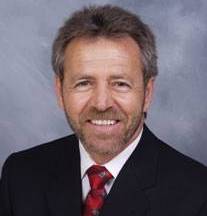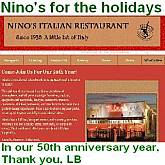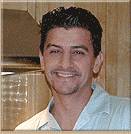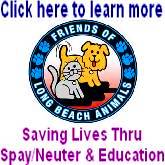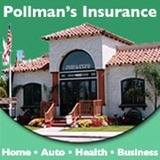|
News AQMD Releases Interactive Carcinogenic Risk Map, Part of Updated MATES-III (Multiple Air Toxics Exposure Study); Map Allows Zoom Into Neighborhoods, Displays Modeled Cancer Risk
(Sept. 10, 2008) -- The South Coast Air Quality Management District (AQMD) has released draft final MATES-III (Multiple Air Toxics Exposure Study), an updated multi-year study that includes an interactive cancer risk map.
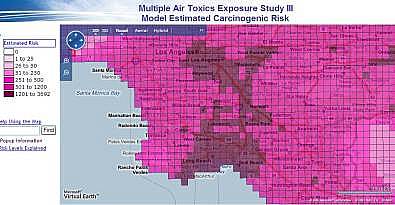
www.aqmd.gov
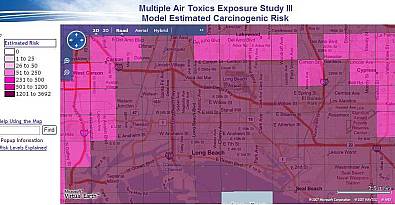
www.aqmd.gov
The map allows users to zoom in on specific neighborhoods to display he study's modeled cancer risk.
To view AQMD's Interactive Cancer Risk Map (MATES-3), click here
Putting one's mouse over a particular area should display a "flag" with data about that local area's model carinogenic risk.
As indicated in the Executive Summary (link below), the modeled carcinogenic risk refers to the average number of additional cancers in a population of one million individuals that are exposed over a 70-year lifetime. Using the MATES III methodology, about 94% of the risk is attributed to emissions associated with mobile sources, and about 6% of the risk is attributed to toxics emitted from stationary sources, which include industries, and businesses such as dry cleaners and chrome plating operations.
Caveats and uncertainties are reported in the Executive Summary pp. E-5 and E-6.
To access the Executive Summary, click here.
For modeling evaluation and assumptions, click here
In its section on Policy Implications, the MATES-III Executive Summary states:
While there has been improvement in air quality regarding air toxics, the risks are still unacceptable and are higher near sources of emissions such as ports and transportation corridors. Diesel particulate continues to dominate the risk from air toxics, and the portion of air toxic risk attributable to diesel exhaust is increased compared to the MATES II Study.
The highest air toxics risks are found near the port area, an area near Central Los Angeles, and near transportation corridors. The results from this study underscore that a continued focus on reduction of toxic emissions, particularly from diesel engines, is needed to reduce air toxics exposure.
An agency release says the MATES-III study, released in draft form in January and revised this year "using
improved computer modeling and emissions inventory methodologies, showed an overall decrease in the cancer risk from air pollution in the region from 931 in 1 million to 853 in 1 million from 1998-1999 to 2005." However, the release continued:
While the region's overall risk decreased, the cancer risk from air pollution around the ports increased by about 17 percent from 1998 to 2005 in spite of ongoing clean up efforts, due to the near-doubling of container shipments. Slight increases were also seen in areas of Riverside County. The increases are likely due to growth in trade at the ports and increased truck traffic and warehouse development in Riverside County.
About 84 percent of all cancer risk from air pollution is due to diesel exhaust from trucks, trains, ships, locomotives and other diesel equipment. The remaining risk is due to toxic emissions from gasoline-powered motor vehicles,
businesses and industrial facilities.
The study results were presented to AQMD's governing board [which includes LB Councilwoman Tonia Reyes Uranga] on Sept. 5.
The study covers two two-year periods: April 2004-March 2005 and April 2005-March 2006. In June 2006, the Ports of LB and L.A. announced their "Clean Air Action Plan," a self-written, non-binding document premised on Port growth with increased container volumes but with reduced emissions through a combination of technological advances, stricter regulatory requirements and capacity expanding infrastructure to speed cargo more efficiently.
The Clean Air Action Plan isn't legally binding and the Ports have reserved the right to amend as they see fit.
In fall 2006, Democrat leadership in the state Assembly blocked in Committee legislation by state Senator Alan Lowenthal (D., LB-Paramount) that would have required "no net increase" in pollution with Port growth. The bill had been supported by voted action of the LB City Council.
Two years earlier, Gpv. Schwarzenegger vetoed a previous version of the bill (also supported by the City of LB) after LB's Board of Harbor Commissioners voiced opposition to the bill.
Sen. Lowenthal, who had called his "no net increase" measures the most important legislation he'd introduced in all his years in the state legislature, said at a CSULB forum in November 2006 that he would reintroduce his "no net increase" measure in 2007...but didn't.
Instead, he introduced SB 974, what he titled his "Port Investment" (container fee) bill, a measure substantively different from a container fee measure by Sen. Lowenthal authored that made it through the state legislature but was vetoed by Governor Schwarzenegger in 2006.
SB 974, now awaiting the Governor's signature or veto, would enact a cargo container fee to fund rail improvements to promote efficiency and provide funding for environmental mitigation...but the measure does not include a legal requirement that the net result of the larger container volumes and new infrastructure will actually be less pollution than at present.
The Ports of LB/L.A. have separately enacted their own local clean air measures, including Clean Trucks programs forbidding the oldest, dirtiest trucks from handling Port cargo. Industry has challenged the Clean Truck programs in federal court; a ruling on an industry-sought injunction is expected Thursday (Sept. 11); the court tentatively ruled in favor of the Ports' authority to enact the Clean Trucks program.
As previously reported by LBReport.com, in 2003 then-Assemblyman Lowenthal and then-Senator Karnette authored a "gut and amend" measure [avoids most legislative hearings] that exempts high-polluting ship bunker fuel from a portion of CA's sales/use tax, a measure estimated to cost CA taxpayers millions of dollars a year in revenue but preserving some local Port related jobs, a position favored by Port area interests.
Earlier this year, a City Council majority brushed back an effort by Councilwoman Gerrie Schipske to put the City of LB on record in favor of repealing the tax break on bunker fuel.
Return To Front Page
Contact us: mail@LBReport.com
|
